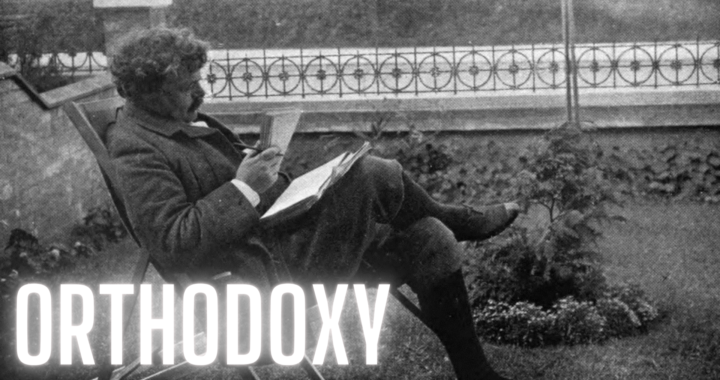My brothers-in-law and I are reading through G.K. Chesterton’s Orthodoxy at the moment, so I’m putting my work-in-progress notes here…
Preface
- GKC refers to his earlier book Heretics, where he critiques ideologies such as communism and anarchy.
- He refers to John Henry Newman, an English theologian who converted from Anglicanism and wrote a spiritual autobiography, Apologia pro vita sua.
1. Introduction in Defence of Everything Else
Why I’m writing this book…
- He refers to journalist George Slythe Street.
- This is what the Royal Pavilion in Brighton looks like.
- When he talks about “romance”, we might better called that “adventure” today.
- He refers to George Bernard Shaw, a socialist friend who often debated GCK.
- He mentions a couple of mythical creatures, the Gorgon and the Griffin.
- The adjective “elephantine” means resembling an elephant i.e clumsy
- An “obmnibus” is another name for a bus bus.
- GKC’s standard of orthodoxy is The Apostles Creed.
2. The Maniac
Sinfulness and sanity
- Hanwell is an area in London known for its asylum.
- A “rotter” is slang for a bad or useless person
- Joanna Southcote was a woman in the 18th/19th Century who preached that she was the woman in Revelation who would give birth to the Messiah
- Reverend R.J. Campbell held to panentheism, which includes God as part of the world.
- Something is “as plain as a pikestaff” if it’s very obvious.
- GCK refers to the American poet and writer, Edgar Allen Poe.
- “Draughts” is the English name for the game of “Checkers”.
- William Cowper (pronounced “cooper”) is cited as an example of someone who had psychological issues, driven by John Calvin’s doctrines of predestination. Chesterton mentions that Cowper was almost saved by John Gilpin, who was a character in Cowper’s comic ballad.
- Necessitarianism is a form of determinism, whereby a person’s will is entirely determined by previous causes.
- The Ouse river is mentioned.
- The artist Hans Holbein is mentioned.
- The English poet John Dryden.
- Candinal Herbert Algfred Vaughan
- George Herbert
- The Clarion was a socialist newspaper started by, among others, Robert B Suthers.
- A Dervish is a member of Muslim group, known for spinning prior to entering traces.
- The term “Inner Circle” is used in a very specific sense, referring to the street in Regent’s Park which surrounds Queen Mary’s Gardens. Gower Street is nearby.
- “Bloody Mary” is Queen Mary I, given this name following her persecution of Protestants.
- Materialism is the belief that all there is in the universe is matter.
- Joseph McCabe was an atheist apologist and former Franciscan.
- Ernst Haeckel was a supporter of Dawinism
- An Imp is a small demon.
- A Pimpernel is a flowering herb.
- Panegoistic says that self-interest is the motive behind all conscious actipm
- Threepenny (pronounced “thupanny”) is a coin worth three pence
- Fatalism is the belief that event are inevitable.
- Theosophists believed that thought gave insight into the nature of God and the universe.
- At the end of the chapter, Chesterton refers to the moon, which was thought to drive people mad (which is why “Lunacy” comes from “Luna”).
- Euclid was a Greek mathematician known as the father of geometry.
3. The Suicide of Thought
Virtue gone wild.
- Henry James was an American-British author.
- Robert Blatchford was an English socialist campaigner.
- Tomas de Torquemada was the first Grand Inquisitor of the Spanish Inquisition.
- Emile Zola was the best-known practitioner of the literary school of naturalism.
- Thomas Henry Huxley was an English biologist and anthropologist who championed Darwinsim.
- Latitudinarians were broad-based Protestants.
- H.G. Wells was a renowned science-fiction writer.
- A miter is a Bishop’s hat
- Rene Descarts was a French Philosopher, best known for the statement “cogito, ergo sum”.
- Friedrich Nietsche was a German philosopher who died in an asylum.
- John Milton was the author of Paradise Lost.
- Alfred, Lord Tennyson was an English poet.
- Mark Twain was an American author of Tom Sawyer and Huckleberry Finn.
- … [Still reading the chapter]
4. The Ethics of Elfland
…
5. The Flag of the World
…
6. The Paradoxes of Christianity
…
7. The Eternal Revolution
…
8. The Romance of Orthodoxy
…
9. Authority and the Adventurer
…
